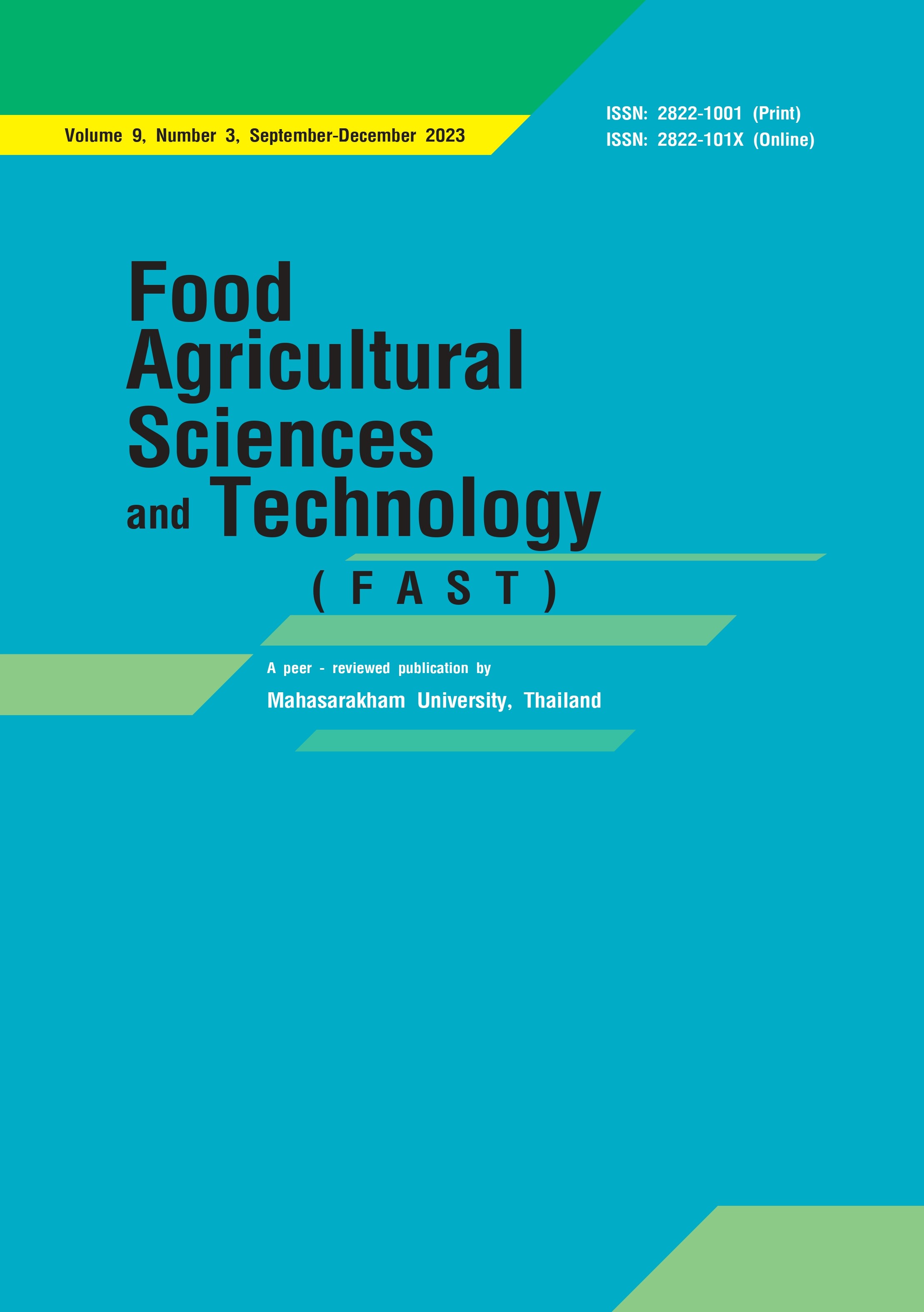Factors affecting the acceptance of transferring innovations in the production of quality cassava stalk to farmers in Pathum Ratchawongsa District, Amnat Charoen Province
Keywords:
Transferring, innovation, production of cassava stalks, Amnat CharoenAbstract
The objectives were to study 1) personal and socioeconomic factors 2) knowledge of cassava production, 3) acceptance of transferring innovations in the production of quality cassava stalk, and 4) problems and obstacles. The sample used in this research were 354 cassava growers, using interview forms for data collection. The study’s results concluded that most of the farmers were male, average age of 50.57, not single, and education level below secondary school. The average number of household members was 4.90 persons, the average cassava planting area was 10.25 rai, and the average planting experience was 12.16 years. The average household size was 3.25 people with not a member of the farmer group, and without their own machinery. Most of farmers had an average income of 12,081.58 baht, and average expenses of 4,849.14 baht. Farmers knew how to produce quality cassava stalks at a high level of knowledge with an average of 26.16 points. There was a high level of acceptance of innovation in the production of quality cassava stalks with an average of 119.29 points. The hypothesis testing found that a member of the farmers group, having their own machinery and knowledge level were related to acceptance of transferring innovations in the production of quality cassava stalk significantly at the 0.01 level. The problems and obstacles encountered were planting labor and the price of labor wages was high. The shortage of water and the stalks where insufficient which government should support training and transferring innovations of quality cassava stalk to farmers.
References
Amnatcharoen Provincial Agricultural extension. (2023). Farmer Registration Database. Department of Agricultural Extension.
Arif, U., Dilawar, K., Shaofeng, Z., & Uzair A. (2018). Factors influencing the adoption of improved cultivars: a case of peach farmers in Pakistan. Ciência Rural, Santa Maria, 48(11) e20180342.
Chaiwat S., C., (2021, September 1). Business/Industry trends 2022-2024: Cassava. https://www.krungsri. com/th/research/industry/industryoutlook/agriculture/cassava/io/ io-cassava-21
Daengfai, P. (2018). Adoption of maize legume relay cropping system grown without burning of farmer in the area of highland development project using Maesalong Royal Project system, Maefahluang District, in Chiang Rai Province. [Master of Science in Resources Development and Agricultural Extension, Maejo University].
Department of Agriculture Extension. (2020). Handbook for the prevention and eradication of cassava leaf spot disease. Ministry of Agriculture and Cooperatives.
Department of Agriculture Extension. (2020). Handbook for the prevention and eradication of cassava leaf spot disease. Ministry of Agriculture and Cooperatives.
Fakkhong, S. & Suwanmaneepong, S. (2017). The implementation of good agricultural practice among rice farmers in Eastern Region of Bangkok, Thailand. International Journal of Agricultural Technology, 13(7), 2509-2522.
Footan, C. Sreshthaputra, S., Intrauccomporn, W., & Pankasemsuk, T. (2017). Factors affecting farmers’ adoption in good agricultural practices for safe vegetable production in Mae Tha Nuea Royal Project Development Center, Chiang Mai Province. Journal of Agriculture, 33(3), 397 - 404.
Harinpaponwich, W., Matae, A., & Dorosae, H. (2020). Study of integrated farming among agriculturists in Muang District, Yala Province. The 11th Hatyai National and International Conference (pp. 137- 148). Hat Yai University, Thailand.
Ketkaewkliang, C., Benchamas, Yooprasert B., & Tangwiwat, P. (2014). Extension needs in cassava production of farmers in Erawan District, Loei. The 5th STOU Graduate Research Conference (p. 12). Sukhothai Thammathirat Open University.
Khonje, M., Mkandawire, P., Manda, J., & Alene, A. (2015). Analysis of adoption and impacts of improved cassava varieties in Zambia. 29th Triennial Conference of the International Association of Agricultural Economists (IAAE) (p. 29).
Niyamangkul, S. (2013). Research methods in social sciences and statistics. Book to you publication.
Office of Agricultural Economics. (2023). Weekly production and marketing situation 25 September - 1 October 2023.
Office of Agricultural Economics. Piangsub, K. (2022). Thai geographical indications of Noh Kala (Alpinia nigra Burtt) in Koh Kret Sub-district, Pak Kret District, Nonthaburi Province. [Master of Science in Agricultural Extension, Kasetsart University.]. Kasetsart University.
Prachachat Thurakit. (2023). Domestic economy: Cassava shortage of 10 million tons. “El Niño” again hits the short supply crisis. Prachachat Thurakit.
Praphaisri, N., Kanokhong, K.,Rungkawat, N, & Sakkatat, P. (2014). Adoption of first rice crop production of farmmers in Mae Ai District, Chiangmai Province. Maejo University.
Ruangtanaapaisuk, N. Choocharoen, C. & Lertsiri, S. (2021). Needs of knowledge on geographical indications registration of large-scale taro farmers in Ban Mo district, Saraburi province. Agricultural Science Journal, 52(2), 213-224.
Saee-Art, P., Fongmul, S., Phutthisun Kruekum, P. & Jeerat, P. (2019). Farmer’s adoption on dry-season rice production technology in Kheuang Municipality, Chiang Khong district, Chiang Rai Province. J. Agri. Prod. 1(2), 51-62.
Suwannapan, M., KhlibtongK, J., & Toomhiran, C. (2018). Extension guidelines for vegetable production of farmers in Tambol Palan, Phayakkhaphum Phisai District, Maha Sarakham Province. The 9th STOU National Research Conference. (pp. 2197-2210). Sukhothai Thammathirat Open University.
Tubtimthawechok, N. (2013). Cognition and the opinion of rice farmer on income guarantee scheme in the southern isan provinces groups, Thailand. National Institute of Development Administration.
Downloads
Published
How to Cite
Issue
Section
License
Copyright (c) 2023 Food Agricultural Sciences and Technology

This work is licensed under a Creative Commons Attribution-NoDerivatives 4.0 International License.








